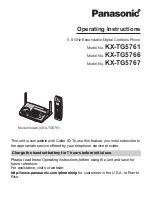
2-5
2
CC007DC
Valve Adjuster Procedure
A. Place the Valve Clearance Adjuster onto the
jam nut securing the tappet adjuster screw; then
rotate the valve adjuster dial clockwise until the
end is seated in the tappet adjuster screw.
B. While holding the valve adjuster dial in place,
use the valve adjuster handle and loosen the
jam nut; then rotate the tappet adjuster screw
clockwise until friction is felt.
C. Align the valve adjuster handle with one of the
marks on the valve adjuster dial.
D. While holding the valve adjuster handle in
place, rotate the valve adjuster dial counter-
clockwise until proper valve/tappet clearance is
attained.
NOTE: Refer to the appropriate specifications in
Feeler Gauge Procedure sub-section for the proper
valve/tappet clearance.
NOTE: Rotating the valve adjuster dial counter-
clockwise will open the valve/tappet clearance by
0.05 mm (0.002 in.) per mark.
E. While holding the adjuster dial at the proper
clearance setting, tighten the jam nut securely
with the valve adjuster handle.
3. Install the timing inspection plug.
4. Place the two tappet covers with O-rings into posi-
tion; then tighten the covers securely.
5. Install the spark plug; then install the timing
inspection plug.
Testing Engine
Compression
To test engine compression, use the following proce-
dure.
1. Remove the high tension lead from the spark plug.
2. Using compressed air, blow any debris from
around the spark plug.
3. Remove the spark plug; then attach the high ten-
sion lead to the plug and ground the plug on the
cylinder head well away from the spark plug hole.
4. Attach the Compression Tester Kit.
NOTE: The engine must be warm and the battery
must be fully charged for this test.
5. While holding the throttle lever in the full-open
position, crank the engine over with the electric
starter until the gauge shows a peak reading of
95-115 psi (five to 10 compression strokes).
6. If compression is abnormally low, inspect the
following items.
A. Verify starter cranks engine over at normal
speed (approximately 400 RPM).
B. Gauge functioning properly.
C. Throttle lever in the full-open position.
D. Valve/tappet clearance correct.
E. Valve not bent or burned.
F. Valve seat not burned.
NOTE: To service valves, see Engine/Transmis-
sion.
7. Pour approximately 30 ml (1 fl oz) of oil into the
spark plug hole, reattach the gauge, and retest
compression.
8. If compression is now evident, service the piston
rings (see Engine/Transmission).
Spark Plug
A light brown insulator indicates that a plug is correct.
A white or dark insulator indicates that the engine may
need to be serviced or the carburetor may need to be
adjusted (350). To maintain a hot, strong spark, keep
the plug free of carbon.
! WARNING
Always wear safety glasses when using compressed
air.
Section
Table of Contents
Manual
Table of Contents
For Discount Arctic Cat Parts Call 606-678-9623 or 606-561-4983
www.mymowerparts.com














































